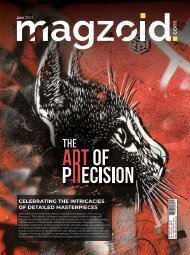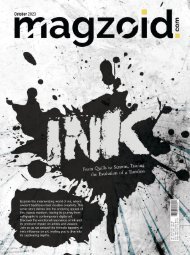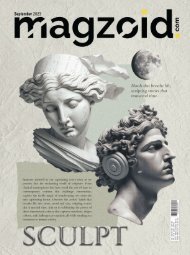Magzoid - Leading Art Magazine: January, 2021
MAGZOID is one of the Leading Art Magazine of the MENA region which has it’s presence Online as well as on the Print Media. Leading Art Magazine for all the Art News, Art Exhibitions, Artist Feature, Art Knowledge, History in Arts, Recent findings in Art world, Global Art Facts and many more.
MAGZOID is one of the Leading Art Magazine of the MENA region which has it’s presence Online as well as on the Print Media. Leading Art Magazine for all the Art News, Art Exhibitions, Artist Feature, Art Knowledge, History in Arts, Recent findings in Art world, Global Art Facts and many more.
- No tags were found...
Create successful ePaper yourself
Turn your PDF publications into a flip-book with our unique Google optimized e-Paper software.
Archaeologists believe they
have discovered the world’s oldest-known
representational artwork:
three wild pigs painted deep in
a limestone cave on the Indonesian
island of Sulawesi at least 45,500
years ago.
The ancient images, revealed this
week in the journal Science Advances,
were found in Leang Tedongnge
cave. Made with red ochre pigment,
the painting appears to depict a
group of Sulawesi warty pigs, two of
which appear to be fighting. Those
two images are badly damaged, but
the third, possibly watching the drama
unfold, remains in near-pristine
condition.
“The world’s oldest surviving representational
image of an animal,” the
paper noted, the painting “may also
constitute the most ancient figurative
artwork known to archaeology.”
“I was struck dumb,” Adam Brumm
of Griffith University, Australia, the
article’s lead author, told NewScientist.
“It’s one of the most spectacular
and well-preserved figurative animal
paintings known from the whole
region, and it just immediately blew
me away.”
Archaeologist Basran Burhan, a Griffith
University PhD student, discovered
the cave and its prehistoric
paintings in December 2017. It’s
only accessible during the dry season,
via a long trek over mountains
through a rough forest path.
Previously, the oldest-known figurative
art was actually from a nearby
cave, Leang Bulu’Sipong, discov-
www.magzoid.com | Page 52
Art News
45,000-Year-Old Cave Painting of a Pig
May Be the Oldest Artwork in the World
ered by the same
team. Announced
in late 2019, that
43,900-yearold
work depicts
eight figures with
weapons in hand
approaching wild
pigs and small native
buffaloes. In 2014,
the archaeologists
also made headlines
with the discovery
of an animal painting
at least 35,700
years old, and hand
stencils from some
40,000 years ago.
As for the oldest
art in the world, “it
depends on what
definition of ‘art’ you use,” Griffith
University archaeologist Maxime
Aubert, one of the paper’s co-authors,
told National Geographic.
“The world’s oldest surviving representational
image of an animal,” the
paper noted, the painting “may also
constitute the most ancient figurative
artwork known to archaeology.”
“I was struck dumb,” Adam Brumm
of Griffith University, Australia, the
article’s lead author, told NewScientist.
“It’s one of the most spectacular
and well-preserved figurative animal
paintings known from the whole
region, and it just immediately blew
me away.”
Archaeologist Basran Burhan, a Griffith
University PhD student, discovered
the cave and its prehistoric
paintings in December 2017. It’s
only accessible during the dry season,
via a long trek over mountains
through a rough forest path.
Previously, the oldest-known figurative
art was actually from a nearby
cave, Leang Bulu’Sipong, discovered
by the same team. Announced
in late 2019, that 43,900-year-old
work depicts eight figures with
weapons in hand approaching wild
pigs and small native buffaloes. In
2014, the archaeologists also made
headlines with the discovery of an
animal painting at least 35,700
years old, and hand stencils from
some 40,000 years ago.
As for the oldest art in the world, “it
depends on what definition of ‘art’
you use,” Griffith University archaeologist
Maxime Aubert, one of the
paper’s co-authors, told National
Geographic.

















